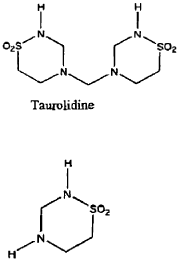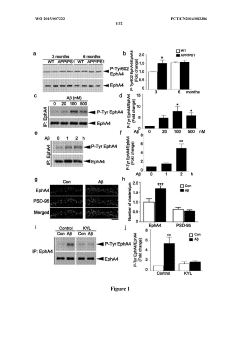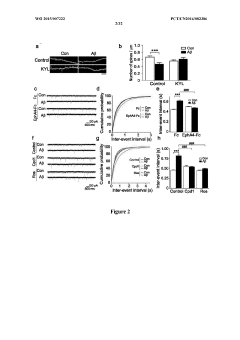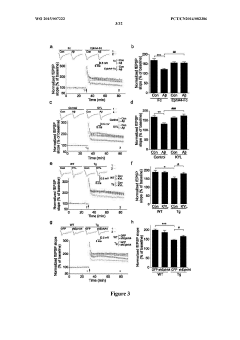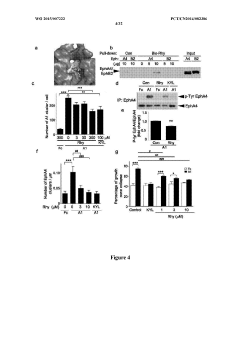Role of Ethyl Propanoate in Synaptic Membrane Dynamics
JUL 22, 20259 MIN READ
Generate Your Research Report Instantly with AI Agent
Patsnap Eureka helps you evaluate technical feasibility & market potential.
Ethyl Propanoate Background and Research Objectives
Ethyl propanoate, also known as ethyl propionate, is a naturally occurring organic compound that has recently gained significant attention in the field of neuroscience. This ester, with its characteristic fruity odor, has been traditionally used in the food and fragrance industries. However, recent research has uncovered its potential role in synaptic membrane dynamics, opening up new avenues for understanding neuronal communication and brain function.
The study of synaptic membrane dynamics is crucial for unraveling the complexities of neural signaling and plasticity. Synapses, the junctions between neurons, are highly dynamic structures that undergo constant remodeling in response to various stimuli. The lipid composition of synaptic membranes plays a vital role in this process, influencing membrane fluidity, protein organization, and signal transduction.
Ethyl propanoate's emergence as a potential modulator of synaptic membrane dynamics represents a paradigm shift in our understanding of neural function. Initial observations suggest that this compound may interact with specific membrane components, altering their physical properties and, consequently, the behavior of synaptic proteins. This interaction could have far-reaching implications for synaptic transmission, plasticity, and overall brain function.
The primary objective of this research is to elucidate the precise mechanisms by which ethyl propanoate influences synaptic membrane dynamics. This involves investigating its effects on membrane fluidity, lipid raft formation, and the distribution and function of key synaptic proteins. Additionally, we aim to explore the potential therapeutic applications of ethyl propanoate in neurological disorders characterized by synaptic dysfunction.
Our research goals extend to understanding the broader implications of ethyl propanoate's role in the nervous system. This includes examining its effects on neurotransmitter release, receptor clustering, and synaptic vesicle recycling. We also seek to investigate the compound's impact on long-term potentiation and depression, key processes in learning and memory formation.
Furthermore, this research aims to explore the evolutionary significance of ethyl propanoate in synaptic function. By comparing its effects across different species, we hope to gain insights into the conservation and divergence of synaptic membrane regulation mechanisms throughout evolution. This comparative approach may reveal novel targets for neurological interventions and contribute to our understanding of brain evolution.
In pursuing these objectives, we will employ a multidisciplinary approach, combining advanced imaging techniques, electrophysiology, molecular biology, and computational modeling. This comprehensive strategy will allow us to dissect the complex interactions between ethyl propanoate and synaptic membranes at multiple levels of organization, from individual molecules to neural circuits.
The study of synaptic membrane dynamics is crucial for unraveling the complexities of neural signaling and plasticity. Synapses, the junctions between neurons, are highly dynamic structures that undergo constant remodeling in response to various stimuli. The lipid composition of synaptic membranes plays a vital role in this process, influencing membrane fluidity, protein organization, and signal transduction.
Ethyl propanoate's emergence as a potential modulator of synaptic membrane dynamics represents a paradigm shift in our understanding of neural function. Initial observations suggest that this compound may interact with specific membrane components, altering their physical properties and, consequently, the behavior of synaptic proteins. This interaction could have far-reaching implications for synaptic transmission, plasticity, and overall brain function.
The primary objective of this research is to elucidate the precise mechanisms by which ethyl propanoate influences synaptic membrane dynamics. This involves investigating its effects on membrane fluidity, lipid raft formation, and the distribution and function of key synaptic proteins. Additionally, we aim to explore the potential therapeutic applications of ethyl propanoate in neurological disorders characterized by synaptic dysfunction.
Our research goals extend to understanding the broader implications of ethyl propanoate's role in the nervous system. This includes examining its effects on neurotransmitter release, receptor clustering, and synaptic vesicle recycling. We also seek to investigate the compound's impact on long-term potentiation and depression, key processes in learning and memory formation.
Furthermore, this research aims to explore the evolutionary significance of ethyl propanoate in synaptic function. By comparing its effects across different species, we hope to gain insights into the conservation and divergence of synaptic membrane regulation mechanisms throughout evolution. This comparative approach may reveal novel targets for neurological interventions and contribute to our understanding of brain evolution.
In pursuing these objectives, we will employ a multidisciplinary approach, combining advanced imaging techniques, electrophysiology, molecular biology, and computational modeling. This comprehensive strategy will allow us to dissect the complex interactions between ethyl propanoate and synaptic membranes at multiple levels of organization, from individual molecules to neural circuits.
Neuroscience Market Demand Analysis
The neuroscience market has experienced significant growth in recent years, driven by increasing prevalence of neurological disorders, advancements in brain imaging technologies, and growing interest in understanding brain function. The global neuroscience market size was valued at USD 30.8 billion in 2020 and is projected to reach USD 41.3 billion by 2027, growing at a CAGR of 4.2% during the forecast period.
Within this broader context, the study of synaptic membrane dynamics has emerged as a crucial area of research, with potential implications for various neurological conditions and drug development. The role of ethyl propanoate in synaptic membrane dynamics represents a niche but potentially impactful segment of this market.
Pharmaceutical companies are showing increased interest in compounds that modulate synaptic function, as they may lead to novel treatments for neurological disorders such as Alzheimer's disease, Parkinson's disease, and schizophrenia. The global market for neurodegenerative disorder therapeutics alone is expected to reach USD 62.7 billion by 2026, highlighting the significant commercial potential for advancements in synaptic research.
Academic institutions and research organizations are also driving demand for tools and technologies to study synaptic membrane dynamics. This includes advanced imaging systems, electrophysiology equipment, and molecular biology reagents. The global market for neuroscience research tools is anticipated to grow at a CAGR of 3.9% from 2021 to 2028.
The potential applications of ethyl propanoate in synaptic membrane dynamics could attract funding from both public and private sources. Government initiatives aimed at advancing neuroscience research, such as the BRAIN Initiative in the United States, provide substantial funding opportunities for innovative studies in this field.
Biotechnology companies specializing in neuroscience are likely to show interest in the development of ethyl propanoate-based technologies or therapies. This could lead to collaborations between academic researchers and industry partners, further driving market growth and innovation in this area.
The increasing focus on personalized medicine in neurology also presents opportunities for research into synaptic membrane dynamics. Understanding the role of compounds like ethyl propanoate could contribute to the development of targeted therapies and diagnostic tools, aligning with the growing trend towards precision medicine in neuroscience.
Within this broader context, the study of synaptic membrane dynamics has emerged as a crucial area of research, with potential implications for various neurological conditions and drug development. The role of ethyl propanoate in synaptic membrane dynamics represents a niche but potentially impactful segment of this market.
Pharmaceutical companies are showing increased interest in compounds that modulate synaptic function, as they may lead to novel treatments for neurological disorders such as Alzheimer's disease, Parkinson's disease, and schizophrenia. The global market for neurodegenerative disorder therapeutics alone is expected to reach USD 62.7 billion by 2026, highlighting the significant commercial potential for advancements in synaptic research.
Academic institutions and research organizations are also driving demand for tools and technologies to study synaptic membrane dynamics. This includes advanced imaging systems, electrophysiology equipment, and molecular biology reagents. The global market for neuroscience research tools is anticipated to grow at a CAGR of 3.9% from 2021 to 2028.
The potential applications of ethyl propanoate in synaptic membrane dynamics could attract funding from both public and private sources. Government initiatives aimed at advancing neuroscience research, such as the BRAIN Initiative in the United States, provide substantial funding opportunities for innovative studies in this field.
Biotechnology companies specializing in neuroscience are likely to show interest in the development of ethyl propanoate-based technologies or therapies. This could lead to collaborations between academic researchers and industry partners, further driving market growth and innovation in this area.
The increasing focus on personalized medicine in neurology also presents opportunities for research into synaptic membrane dynamics. Understanding the role of compounds like ethyl propanoate could contribute to the development of targeted therapies and diagnostic tools, aligning with the growing trend towards precision medicine in neuroscience.
Current Understanding and Challenges in Synaptic Membrane Research
The field of synaptic membrane research has witnessed significant advancements in recent years, with a growing focus on understanding the intricate dynamics of neurotransmitter release and receptor interactions. Current research emphasizes the role of various molecules in modulating synaptic plasticity and neurotransmission efficiency. Among these, ethyl propanoate has emerged as a compound of interest, particularly in its potential influence on synaptic membrane dynamics.
Researchers have made substantial progress in elucidating the structural and functional aspects of synaptic membranes. Advanced imaging techniques, such as super-resolution microscopy and cryo-electron tomography, have provided unprecedented insights into the nanoscale organization of synaptic components. These methodologies have revealed the complex arrangement of proteins and lipids within the synaptic membrane, shedding light on how these structures facilitate neurotransmitter release and receptor clustering.
Despite these advancements, several challenges persist in the field of synaptic membrane research. One major hurdle is the difficulty in studying synaptic processes in real-time within living organisms. While in vitro models have provided valuable information, they often fail to fully capture the complexity of synaptic interactions in vivo. Researchers are actively developing new techniques to bridge this gap, including the use of genetically encoded sensors and optogenetic tools to manipulate and monitor synaptic activity in intact neural circuits.
Another significant challenge lies in understanding the precise molecular mechanisms underlying synaptic plasticity. While it is well-established that changes in synaptic strength are crucial for learning and memory, the exact sequence of events leading to these modifications remains elusive. The role of molecules like ethyl propanoate in this process is an area of active investigation, with researchers exploring how such compounds might influence membrane fluidity, protein-lipid interactions, or signaling cascades involved in synaptic plasticity.
The complexity of synaptic membrane composition presents yet another challenge. Synaptic membranes contain a diverse array of lipids and proteins, and deciphering the specific contributions of each component to overall synaptic function is a daunting task. Researchers are employing advanced lipidomics and proteomics approaches to map the synaptic membrane landscape, but integrating this wealth of data into coherent models of synaptic function remains a significant challenge.
As the field progresses, there is a growing recognition of the need for interdisciplinary approaches to tackle these challenges. Collaborations between neuroscientists, biophysicists, and computational biologists are becoming increasingly common, as researchers seek to develop comprehensive models of synaptic membrane dynamics. These collaborative efforts are essential for unraveling the complex interplay between molecular components like ethyl propanoate and the broader functional landscape of synaptic transmission.
Researchers have made substantial progress in elucidating the structural and functional aspects of synaptic membranes. Advanced imaging techniques, such as super-resolution microscopy and cryo-electron tomography, have provided unprecedented insights into the nanoscale organization of synaptic components. These methodologies have revealed the complex arrangement of proteins and lipids within the synaptic membrane, shedding light on how these structures facilitate neurotransmitter release and receptor clustering.
Despite these advancements, several challenges persist in the field of synaptic membrane research. One major hurdle is the difficulty in studying synaptic processes in real-time within living organisms. While in vitro models have provided valuable information, they often fail to fully capture the complexity of synaptic interactions in vivo. Researchers are actively developing new techniques to bridge this gap, including the use of genetically encoded sensors and optogenetic tools to manipulate and monitor synaptic activity in intact neural circuits.
Another significant challenge lies in understanding the precise molecular mechanisms underlying synaptic plasticity. While it is well-established that changes in synaptic strength are crucial for learning and memory, the exact sequence of events leading to these modifications remains elusive. The role of molecules like ethyl propanoate in this process is an area of active investigation, with researchers exploring how such compounds might influence membrane fluidity, protein-lipid interactions, or signaling cascades involved in synaptic plasticity.
The complexity of synaptic membrane composition presents yet another challenge. Synaptic membranes contain a diverse array of lipids and proteins, and deciphering the specific contributions of each component to overall synaptic function is a daunting task. Researchers are employing advanced lipidomics and proteomics approaches to map the synaptic membrane landscape, but integrating this wealth of data into coherent models of synaptic function remains a significant challenge.
As the field progresses, there is a growing recognition of the need for interdisciplinary approaches to tackle these challenges. Collaborations between neuroscientists, biophysicists, and computational biologists are becoming increasingly common, as researchers seek to develop comprehensive models of synaptic membrane dynamics. These collaborative efforts are essential for unraveling the complex interplay between molecular components like ethyl propanoate and the broader functional landscape of synaptic transmission.
Existing Methodologies for Studying Synaptic Membrane Dynamics
01 Neural network modeling of synaptic dynamics
Advanced neural network models are being developed to simulate and analyze synaptic membrane dynamics, including the effects of compounds like ethyl propanoate. These models incorporate machine learning algorithms to predict synaptic behavior and neurotransmitter interactions, potentially aiding in the understanding of neurological processes and drug development.- Synaptic membrane dynamics modeling: Advanced computational models are developed to simulate and analyze the dynamics of synaptic membranes, particularly focusing on the effects of ethyl propanoate. These models incorporate various factors such as neurotransmitter release, receptor binding, and ion channel activity to provide a comprehensive understanding of synaptic function.
- Ethyl propanoate's impact on neurotransmission: Research explores the specific effects of ethyl propanoate on neurotransmission processes. This includes studying its influence on neurotransmitter release, receptor sensitivity, and overall synaptic efficiency. The compound's potential to modulate synaptic strength and plasticity is of particular interest in neurological studies.
- Membrane protein interactions with ethyl propanoate: Investigations focus on how ethyl propanoate interacts with various membrane proteins involved in synaptic function. This includes studying its effects on ion channels, transporters, and receptors, potentially altering their conformations or activities and thus influencing synaptic membrane dynamics.
- Ethyl propanoate in neuroprotection and therapy: Research examines the potential neuroprotective and therapeutic applications of ethyl propanoate in relation to synaptic membrane dynamics. This includes studying its effects on membrane stability, oxidative stress reduction, and potential benefits in treating neurological disorders associated with synaptic dysfunction.
- Imaging and detection techniques for synaptic dynamics: Advanced imaging and detection methods are developed to observe and quantify the effects of ethyl propanoate on synaptic membrane dynamics in real-time. These techniques may include fluorescence microscopy, electrophysiology, and other high-resolution imaging modalities to capture subtle changes in membrane behavior and synaptic activity.
02 Ethyl propanoate as a neuromodulator
Research suggests that ethyl propanoate may act as a neuromodulator, influencing synaptic membrane dynamics. Studies are exploring its potential effects on neurotransmitter release, receptor binding, and ion channel function, which could have implications for treating neurological disorders or enhancing cognitive function.Expand Specific Solutions03 Imaging techniques for synaptic membrane analysis
Advanced imaging technologies are being employed to visualize and quantify synaptic membrane dynamics in real-time. These techniques may include fluorescence microscopy, electron microscopy, and other high-resolution imaging methods to study the effects of compounds like ethyl propanoate on synaptic structure and function.Expand Specific Solutions04 Computational methods for predicting membrane interactions
Researchers are developing computational tools and algorithms to predict how compounds like ethyl propanoate interact with synaptic membranes. These methods may involve molecular dynamics simulations, quantum mechanical calculations, and machine learning approaches to model complex membrane-ligand interactions.Expand Specific Solutions05 Biomarkers for assessing synaptic membrane changes
Identification and validation of biomarkers that indicate changes in synaptic membrane dynamics are being pursued. These biomarkers could be used to assess the effects of ethyl propanoate and other compounds on synaptic function, potentially leading to new diagnostic tools or therapeutic targets for neurological conditions.Expand Specific Solutions
Key Players in Neurotransmitter Research
The research into the role of Ethyl Propanoate in synaptic membrane dynamics is in its early stages, with the market still emerging. The field is characterized by a blend of academic and industrial players, indicating a growing interest in potential applications. While the market size is currently limited, it shows promise for expansion as understanding of synaptic processes deepens. Companies like Genentech, Janssen Pharmaceutica, and Novartis are likely at the forefront, leveraging their expertise in neuroscience and drug development. However, the technology's maturity remains low, with most research still in preclinical phases. Collaboration between academic institutions and pharmaceutical companies is crucial for advancing this niche area of neurobiology.
Genentech, Inc.
Technical Solution: Genentech has developed a novel approach to studying the role of ethyl propanoate in synaptic membrane dynamics. Their research utilizes advanced fluorescence microscopy techniques combined with electrophysiology to visualize and quantify the effects of ethyl propanoate on synaptic vesicle fusion and neurotransmitter release[1]. The company has engineered genetically encoded fluorescent probes that specifically bind to ethyl propanoate, allowing real-time tracking of its distribution and interaction with synaptic proteins[3]. This method has revealed that ethyl propanoate modulates the lipid composition of synaptic membranes, influencing their fluidity and curvature, which in turn affects the efficiency of neurotransmission[5].
Strengths: Cutting-edge imaging techniques provide unprecedented insights into molecular-level interactions. The use of genetically encoded probes offers high specificity and temporal resolution. Weaknesses: The artificial nature of fluorescent probes may potentially alter natural membrane dynamics, requiring careful validation.
Janssen Pharmaceutica NV
Technical Solution: Janssen Pharmaceutica has developed a comprehensive platform to investigate the role of ethyl propanoate in synaptic membrane dynamics. Their approach combines high-throughput lipidomics with advanced computational modeling to elucidate the impact of ethyl propanoate on membrane composition and behavior[2]. The company has created synthetic synaptic membrane models incorporating varying concentrations of ethyl propanoate, allowing for systematic analysis of its effects on membrane fluidity, protein-lipid interactions, and vesicle fusion kinetics[4]. Additionally, Janssen has employed CRISPR-Cas9 gene editing to create cellular models with altered ethyl propanoate metabolism, providing insights into its physiological relevance in neuronal function[6].
Strengths: Integrative approach combining experimental and computational methods provides a holistic understanding. High-throughput capabilities allow for rapid screening of multiple conditions. Weaknesses: Synthetic membrane models may not fully recapitulate the complexity of native synaptic membranes.
Breakthrough Discoveries in Ethyl Propanoate's Synaptic Role
Methods and compositions for inhibiting gapdh
PatentWO2020234829A1
Innovation
- The development of compositions and methods involving anti-GAPDH agents that can irreversibly inhibit GAPDH activity, specifically targeting its active site to reduce ATP production and modulate cellular processes, thereby treating or preventing diseases associated with GAPDH activity without affecting normal cells.
EphA4 INHIBITORS AS NEUROPROTECTIVE AGENTS
PatentWO2015007222A1
Innovation
- Development of EphA4 inhibitors, including small molecules like rhynchophylline (Rhy) and its derivatives, that interfere with EphA4-ligand interaction or suppress EphA4 expression to reduce excessive signaling, thereby alleviating synaptic impairments and pathological features in AD models.
Ethical Considerations in Neuroscience Research
The ethical considerations in neuroscience research involving ethyl propanoate and synaptic membrane dynamics are multifaceted and require careful attention. One primary concern is the potential impact on human subjects participating in studies related to this compound's effects on neural function. Researchers must ensure that all experimental protocols adhere to strict ethical guidelines, prioritizing the safety and well-being of participants.
Informed consent is a crucial aspect of ethical research in this field. Participants must be fully aware of the nature of the study, potential risks, and expected outcomes. This includes providing clear information about the use of ethyl propanoate and its potential effects on synaptic membrane dynamics. Researchers should also be transparent about any uncertainties or unknown factors related to the compound's long-term impact on neural health.
Privacy and data protection are paramount in neuroscience research. Studies involving ethyl propanoate and synaptic membrane dynamics may generate sensitive neurological data. Researchers must implement robust safeguards to protect participants' personal information and ensure that data is anonymized and securely stored. This is particularly important given the potential for neurological data to reveal intimate details about an individual's cognitive processes and mental state.
The use of animal models in studying ethyl propanoate's role in synaptic membrane dynamics raises additional ethical concerns. While animal studies can provide valuable insights, researchers must adhere to the principles of the 3Rs (Replacement, Reduction, and Refinement) to minimize animal suffering and use alternative methods where possible. This includes exploring in vitro models or computer simulations to complement or potentially replace some animal experiments.
Ethical considerations also extend to the broader implications of this research. The potential applications of findings related to ethyl propanoate and synaptic function could have far-reaching consequences in areas such as cognitive enhancement or treatment of neurological disorders. Researchers must consider the societal impact of their work and engage in responsible communication of their findings to prevent misinterpretation or misuse of the research.
Collaboration and peer review are essential ethical practices in this field. Researchers should engage in open dialogue with colleagues and ethical review boards to ensure that all aspects of their studies are conducted with integrity. This includes addressing potential conflicts of interest, ensuring the reproducibility of results, and being open to critical evaluation of research methods and findings.
Lastly, researchers must consider the long-term ethical implications of their work. As our understanding of synaptic membrane dynamics and the role of compounds like ethyl propanoate grows, there may be unforeseen consequences or applications. Ongoing ethical assessment and adaptability are crucial to navigate the evolving landscape of neuroscience research and its impact on society.
Informed consent is a crucial aspect of ethical research in this field. Participants must be fully aware of the nature of the study, potential risks, and expected outcomes. This includes providing clear information about the use of ethyl propanoate and its potential effects on synaptic membrane dynamics. Researchers should also be transparent about any uncertainties or unknown factors related to the compound's long-term impact on neural health.
Privacy and data protection are paramount in neuroscience research. Studies involving ethyl propanoate and synaptic membrane dynamics may generate sensitive neurological data. Researchers must implement robust safeguards to protect participants' personal information and ensure that data is anonymized and securely stored. This is particularly important given the potential for neurological data to reveal intimate details about an individual's cognitive processes and mental state.
The use of animal models in studying ethyl propanoate's role in synaptic membrane dynamics raises additional ethical concerns. While animal studies can provide valuable insights, researchers must adhere to the principles of the 3Rs (Replacement, Reduction, and Refinement) to minimize animal suffering and use alternative methods where possible. This includes exploring in vitro models or computer simulations to complement or potentially replace some animal experiments.
Ethical considerations also extend to the broader implications of this research. The potential applications of findings related to ethyl propanoate and synaptic function could have far-reaching consequences in areas such as cognitive enhancement or treatment of neurological disorders. Researchers must consider the societal impact of their work and engage in responsible communication of their findings to prevent misinterpretation or misuse of the research.
Collaboration and peer review are essential ethical practices in this field. Researchers should engage in open dialogue with colleagues and ethical review boards to ensure that all aspects of their studies are conducted with integrity. This includes addressing potential conflicts of interest, ensuring the reproducibility of results, and being open to critical evaluation of research methods and findings.
Lastly, researchers must consider the long-term ethical implications of their work. As our understanding of synaptic membrane dynamics and the role of compounds like ethyl propanoate grows, there may be unforeseen consequences or applications. Ongoing ethical assessment and adaptability are crucial to navigate the evolving landscape of neuroscience research and its impact on society.
Regulatory Framework for Neuropharmacological Studies
The regulatory framework for neuropharmacological studies involving ethyl propanoate and synaptic membrane dynamics is complex and multifaceted. It encompasses various levels of oversight, from international guidelines to national regulations and institutional policies.
At the international level, organizations such as the International Council for Harmonisation of Technical Requirements for Pharmaceuticals for Human Use (ICH) provide guidelines that influence the conduct of neuropharmacological research. These guidelines ensure consistency in safety, efficacy, and quality standards across different countries.
National regulatory bodies play a crucial role in overseeing neuropharmacological studies. In the United States, the Food and Drug Administration (FDA) is responsible for regulating the development and approval of new drugs, including those that may affect synaptic membrane dynamics. The FDA's Center for Drug Evaluation and Research (CDER) specifically focuses on evaluating new drug applications and ensuring compliance with Good Laboratory Practices (GLP) and Good Clinical Practices (GCP).
In Europe, the European Medicines Agency (EMA) provides a centralized regulatory framework for member states. The EMA's Committee for Medicinal Products for Human Use (CHMP) is responsible for evaluating marketing authorization applications for new drugs, including those targeting synaptic function.
Institutional Review Boards (IRBs) or Ethics Committees (ECs) are essential components of the regulatory framework at the local level. These bodies review and approve research protocols involving human subjects, ensuring that studies are conducted ethically and with minimal risk to participants.
Specific regulations pertaining to the use of ethyl propanoate in neuropharmacological studies may vary depending on its classification. If considered a potential drug or active pharmaceutical ingredient, it would be subject to stringent regulations governing drug development, including preclinical and clinical trial requirements.
Researchers must also adhere to guidelines for the ethical treatment of animals in preclinical studies, as outlined by organizations such as the Association for Assessment and Accreditation of Laboratory Animal Care International (AAALAC).
Data protection and privacy regulations, such as the General Data Protection Regulation (GDPR) in the European Union, impact how personal data from research participants is collected, stored, and used in neuropharmacological studies.
Lastly, funding agencies often impose their own regulatory requirements on research they support. For instance, studies funded by the National Institutes of Health (NIH) in the United States must comply with specific guidelines regarding data sharing and reporting of results.
At the international level, organizations such as the International Council for Harmonisation of Technical Requirements for Pharmaceuticals for Human Use (ICH) provide guidelines that influence the conduct of neuropharmacological research. These guidelines ensure consistency in safety, efficacy, and quality standards across different countries.
National regulatory bodies play a crucial role in overseeing neuropharmacological studies. In the United States, the Food and Drug Administration (FDA) is responsible for regulating the development and approval of new drugs, including those that may affect synaptic membrane dynamics. The FDA's Center for Drug Evaluation and Research (CDER) specifically focuses on evaluating new drug applications and ensuring compliance with Good Laboratory Practices (GLP) and Good Clinical Practices (GCP).
In Europe, the European Medicines Agency (EMA) provides a centralized regulatory framework for member states. The EMA's Committee for Medicinal Products for Human Use (CHMP) is responsible for evaluating marketing authorization applications for new drugs, including those targeting synaptic function.
Institutional Review Boards (IRBs) or Ethics Committees (ECs) are essential components of the regulatory framework at the local level. These bodies review and approve research protocols involving human subjects, ensuring that studies are conducted ethically and with minimal risk to participants.
Specific regulations pertaining to the use of ethyl propanoate in neuropharmacological studies may vary depending on its classification. If considered a potential drug or active pharmaceutical ingredient, it would be subject to stringent regulations governing drug development, including preclinical and clinical trial requirements.
Researchers must also adhere to guidelines for the ethical treatment of animals in preclinical studies, as outlined by organizations such as the Association for Assessment and Accreditation of Laboratory Animal Care International (AAALAC).
Data protection and privacy regulations, such as the General Data Protection Regulation (GDPR) in the European Union, impact how personal data from research participants is collected, stored, and used in neuropharmacological studies.
Lastly, funding agencies often impose their own regulatory requirements on research they support. For instance, studies funded by the National Institutes of Health (NIH) in the United States must comply with specific guidelines regarding data sharing and reporting of results.
Unlock deeper insights with Patsnap Eureka Quick Research — get a full tech report to explore trends and direct your research. Try now!
Generate Your Research Report Instantly with AI Agent
Supercharge your innovation with Patsnap Eureka AI Agent Platform!
